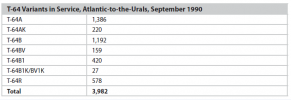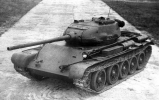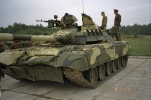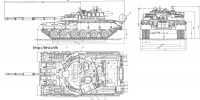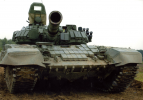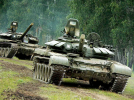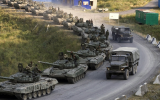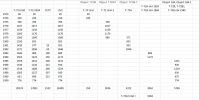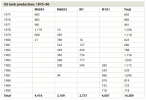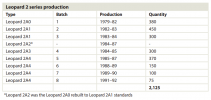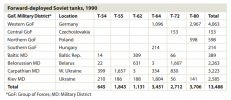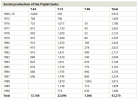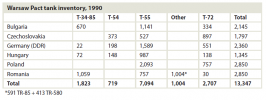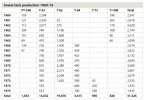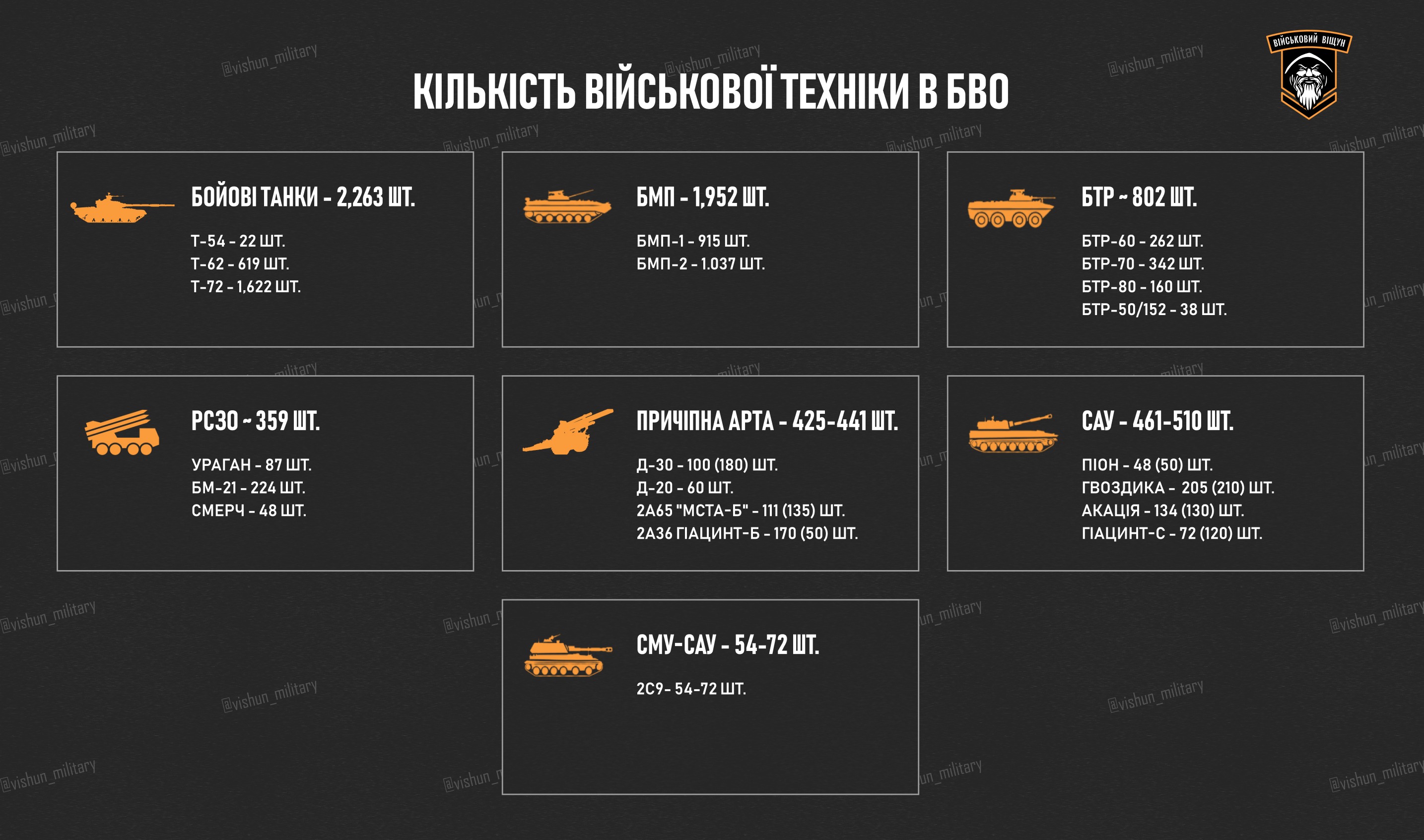Neuvostoliiton T-72 panssarivaunujen kehityksestä 1970- ja 1980-luvuilla.
Lähde:
Tanks at the Iron Curtain 1975-90 - Steven J. Zaloga - kirja julkaistu 24.10.2023
Lainaus kirjan sivuilta 17-18.
T-72: the mobilization tank
Development of an improved T-72 began in May 1975. The original T-72 was inferior to the T-64A in protection. Although it shared the same glacis plate with combination armor, the turret was homogenous cast steel, lacking the aluminum or ceramic insert used in the T-64A turret. A number of different protection options were tested, finally settling on the 172.10.073SB Kvartz turret which added a sintered quartz filler (peschanye sterzhni) in front cavities of the turret. This feature entered production during the final production run of the baseline T-72 tanks at Nizhni-Tagil in July 1978 and was nicknamed the “Dolly Parton” in NATO.
Although the design bureau at Nizhni-Tagil proposed a wide range of upgrades to the T-72, this was resisted by defense minister Dmitry Ustinov. He viewed the T-72 as a second-rate mobilization tank suitable for second tier units and for export. He favored a conversion of the Nizhni-Tagil plant to the T-80. Proposals for expensive T-72 options, such as guided projectiles and advanced fire controls, were rejected in favor of the premium tanks such as the T-64A and T-80.
In conjunction with the turret armor improvements, the T-72 upgrade program examined modest fire control improvements. The TPD-2-49 optical rangefinder was replaced by the TPD-K1 laser rangefinder in the late production T-72 (172M sb4) in 1978. New production tanks with the full upgrade package were designated T-72A and entered production at Nizhni-Tagil in September 1978; it was formally accepted for service on June 22, 1979.
A series of incremental upgrades continued on the T-72A including steel reinforced rubber side skirts in January 1979 on the T-72A (172M sb6). An improved combination armor for the glacis plate entered production in October 1979 that switched from the original 80mm steel–105mm GRP–20mm steel sandwich to a 60–105–50mm sandwich. Tests of Israeli M111 105mm APFSDS projectiles obtained by the Soviet Army in the wake of the 1982 Lebanon War suggested that the glacis plate was still vulnerable. As a short-term solution, a 16mm steel appliqué plate was added to the front of the glacis plate starting in 1983.
A program to modernize the T-72A began in July 1981 as Izdeliye 184. The turret armor was substantially revised by the use of semi-active armor as described earlier. The new turret offered the equivalent of 500–520mm of rolled homogenous armor against APFSDS and 600–620mm against HEAT warheads. Limited production of the new turrets began on July 1, 1983, alongside the earlier Kvartz turret on late-production T-72A tanks. The complete switch to the new turret took place on January 1, 1984. This version was nicknamed the “Super Dolly Parton” in NATO.
Unlike the T-64 and T-80, the initial production versions of the T-72 could not fire guided projectiles such as the Kobra missile. In March 1982, work began on the Izdeliye 177 that was fitted with the new 9K120 Svir missile system and in February 1983 a study began on the Izdeliye 179 with the Kobra missile system. In February 1984, operational trials were conducted of the various upgrades to the T-72A.
A formal start of production of the T-72B was on November 27, 1984. The T-72B had the new 9K120 Svir missile system, the new 172.10.100SB turret adapted to mount the new 1K13-49 gunner’s sight, Kontakt-1 ERA, the improved 2A46M 125mm gun, and the uprated 840hp V-84-1 engine. Some of the final production batches of T-72A manufactured in 1983–84 had some of the features associated with the T-72B including the new turret, but lacked the Svir missile system and the Kontakt-1. In December 1985, production of the T-72B1 began and was completed in September 1989. It was the same as the T-72B but lacked the Svir missile system to reduce the cost of the tank. Armor protection on the T-72B continued with an improved configuration of semi-active armor in the casting of a new turret. The glacis armor was also changed, with the gap between the outer and inner steel armor plates now filled with four spaced steel plates of 10–10–20–20mm instead of the GRP sandwich used in earlier configurations. These armor upgrades were introduced into T-72B production in October 1987.
The final upgrade package for the T-72B was dubbed T-72B Usovershenstvovanniy (“Improved”; 188 SB; T-72BM). This substituted the new Kontakt-5 ERA for the Kontakt-1. Various other upgrades were tested including the improved 2A66 Anker 125mm gun, the Shtora anti-missile optical jammer, and the Agava thermal imaging gunner’s sight. Production of the T-72B tank at Nizhni-Tagil formally ended on November 13, 1991. A small production run of the T-72BM (188-1) with Kontakt-5 took place prior to the collapse of the USSR, but many of the other upgrades did not occur until the advent of the re-named T-90 in August 1991.
-
Tässä on useita kiinnostavia yksityiskohtia, mutta tartun ensimmäisenä viimeisen kappaleen tekstiin jossa kirjoitetaan T-72BM / Product 188-1 panssarivaunuista eli T-72BU eli T-90 obr 1992 edeltäjästä.
Ustyantsevin Nizhny Tagilin eli UVZ:n historiaa käsittelevän kirjan lopusta löytyy tällainen maininta:
LÄHDE
T-72SM ("PRODUCT 188-1")
1987
An improved T-72B tank, developed as part of the “Improvement-72B” design project and equipped, among other things, with a KDZ, a TSHU-1 optoelectronic suppression system, a 140-1 sighting system, a 2A46M cannon and a B-84-1 engine. In experimental development, he received the index "product 188-1". In 1989, two prototypes of the tank passed state tests. The tank "product 188-1" was adopted by the Russian army by a decree of the government of the Russian Federation of October 5, 1992 (order of the Minister of Defense of April 28, 1993) under the name "tank T-72BM". However, this tank was not mass-produced.
Zalogan mukaan vaunuja olisi valmistettu "a small production run...prior to the collapse of the USSR" kun taas Ustyantsev kirjoittaa kahdesta testit läpäisseestä prototyyppivaunusta.
-
HARMITTAVASTI Zalogan kirja ei kommentoi T-72B obr 1989 vaunuja sanallakaan.
Ustyantsev kirjoittaa T-72B vaunuja käsittelevässä kuvauksessaan näin:
Since March 1989, a complex of built-in reactive armor has been installed on the turret, upper front part of the hull and fenders. T-72B is in service research institutes of the Russian army and the armies of a number of foreign countries.
ELI Kontakt-5 elementeillä varustetut T-72B vaunut olivat todellakin sarjatuotannossa ??.3.1989 jälkeen - mutta missä suhteessa Kontakt-1 varusteltuihin vaunuihin? Korvasivatko ne kokonaan vai valmistettiinko molempia rinnakkain?
Vaikuttaa siltä että T-72B obr 1989 oli todellakin osa kylmän sodan todellisuutta ihan sen viimeisinä vuosina - mutta mikä määrä niitä valmistettiin ja minä vuosina?
Olen aina kamppaillut tämän kanssa, koska asiasta ei ole kirjoitettu selvästi tai ainakaan sellaista lähdettä ei ole tullut vastaan. Teoriassa Ustyantsevin kirjoittaman perusteella olisi mahdollista että T-72B obr 1989 voisi käsittää 10/12 osaa vuoden 1989 T-72B tuotannosta, koko vuoden 1990 tuotannon ja 11,5/12 osaa vuoden 1991 tuotannosta - tosin tällöin jätetään vientiin tarkoitetut T-72S pois laskuista. Kenties myös muita, mahdollisesti samaan aikaan tuotannossa olleita malleja.
Minulla on kuitenkin ongelmia suhteuttaa tämä tulkinta UVZ:n väitettyjen tuotantomäärien kanssa:
LÄHDE
1989: 933
1990: 776
1991: ?
Vaikuttaisi siltä että tuolla logiikalla T-72B obr 1989 vaunuja täytyisi olla ainakin 1 553 kpl vuoden 1990 lopussa.
JOS näin todellakin olisi ollut, niin miksi tämä vaunutyyppi on (ainakin näennäisesti) niin harvinainen? En muista nähneeni niitä Tsetsenian ensimmäisessä tai toisessa sodassa (toki kyseisiin sotiin lähetetyt joukko-osastot määrittivät sen, millä kalustolla siellä operoitiin). Uskon että näitä on valmistettu jokunen sata, mutta tuskin kuitenkaan tuhatta vaunua - muuten sen luulisi olevan yleisempi eikä kenties olisi ollut tarvetta T-72BA modernisointiohjelmalle 2000-luvun alussa?
T-80UD oli toinen merkittävä Kontakt-5 elementtejä sisältänyt massatuotettu kylmän sodan aikainen panssarivaunu.
T-80U voidaan laskea kolmanneksi, mutta niiden valmistusmäärät jäivät pieneksi ollen noin 200 kpl vuoden 1991 lopuksi (50kpl LKZ:n tuotantoa vuonna 1989 ja 150 kpl Omskin tuotanto vuonna 1991 - mahdollisesti Kharkovan tehtaan tuotantoa muutama kymmenen vaunua 1983 ja 1984 mutta minulla ei ole tälle varmaa lähdettä).
Kuvaavaa lienee se, että T-80UD vaunuja oli sijoitettuna Moskovan hoviyksiköiden käyttöön ja ne nähtiin Moskovan paraatissa vuonna 1990 mutta T-80U vaunut loistivat poissaolollaan Neuvostoliiton viimeisinä vuosina. JOS niiden sarjatuotanto olisi todella alkanut Omskissa vuonna 1987, niin miksei vaunuja osoitettu tietyille yksiköille? Miksei niitä nähty paraateissa?
Muistutan, että UVZ aloitti T-72BA modernisointiprojektin vaunujen toimittamisen vuoden 2000 tienoilla, mutta sen alkupuolella modernisoidut T-72 vaunut oli varustettu Kontakt-1 elementeillä ja vasta myöhemmin ne korvattiin Kontakt-5 elementeillä. Koko projekti oli muutenkin oman aikansa tuote eli saman mallinimen alla on monia eri variantteja. Virallisesti T-72BA hyväksyttiin Venäjän asevoimien käyttöön vuonna 2005.
-
Toinen havainto, mikä on toki ollut tiedossa jo aikaisemmin mutta hyvä silti sanoa ääneen: T-72A obr 1983 on todellinen ja olemassaoleva variantti mutta sen yleisyys ei ole selvää. Ainakaan Zalogan mukaan koko vuoden 1983 tuotanto ei ole niitä eikä välttämättä edes koko puolen vuoden tuotanto:
Limited production of the new turrets began on July 1, 1983, alongside the earlier Kvartz turret on late-production T-72A tanks. The complete switch to the new turret took place on January 1, 1984.
Eli rajoitettu uusien tornien valmistus alkoi 1.7.1983 mutta se tapahtui rinnakkain aikaisempien Kvartz-tornien kanssa.
Toisaalta uudet tornit korvasivat vanhat tornit 1.1.1984 alkaen eli tästä nähdään että T-72A obr 1984 mallin valmistus käsittää melkoin koko vuoden 1984 tuotannon:
A formal start of production of the T-72B was on November 27, 1984.
Eli voidaan arvioida että T-72A obr 1984 voisi käsittää 11/12 osaa vuoden 1984 tuotannosta ja T-72B puolestaan 1/12 osaa? Kenties, toki tässä oletetaan että koko vuoden tuotanto olisi muuten tasan jakautunut kuukausien kesken eli ei olisi nähty minkäänlaista hetkellistä laskua.
Zalogan mukaan UVZ:n T-72B tuotanto tapahtui aikavälillä:
27.11.1984 - 13.11.1991 (eli melko tasan seitsemän vuotta)
Samoin hänen mukaansa UVZ:n T-72B1 tuotanto tapahtui aikavälillä:
??.12.1985 - ??.9.1989 (eli kenties kolme vuotta ja kymmenen kuukautta?)
Tästä herää toki kysymys: eikö UVZ valmistanut yhtään T-72B vaunua vuonna 1992 tai 1993? Zalogan kirja on aika selväsanainen että tuotanto päättyi tuolloin. He pyrkivät saavaan T-90 panssarivaunun sarjatuotantoon ja samaan aikaan etsivät T-72S vaunuille ulkomaisia ostajia. T-72S tuotannosta ei ole selviä vuosikohtaisia määriä mutta Ustyantsevin kirjan mukaan niiden valmistus olisi alkanut vuonna 1987 ja hän kirjoittaa niiden valmistusmäärästä näin:
In total, according to some reports, a little more than 400 T-72S tanks were manufactured.
Toki tässä väistetään vastuunottaminen numeron oikeudesta, kun kirjoitetaan että "tiettyjen raporttien mukaan".
Zalogan kirjasta "T-90 standard tank: the first tank of the new Russia" (kirja julkaistu 20.2.2018 - alleviivaus minun)
In 1992, the Russian Army ordered only 20 tanks: 5 T-80U tanks from Omsk and 15 tanks from Nizhni-Tagil. Tank production at Omsk and Nizhni-Tagil in 1992–93 was well beyond the puny state orders due to some export orders, but only a pale shadow of the 1980s. This additional production was not ordered by the Russian Army, but undertaken simply to keep the plants from closing. There was the hope that large export orders would emerge to save the plants and sop up this surplus. However the anticipated export orders did not materialize. The UVZ in Nizhni-Tagil had about 350 T-72S and T-90 tanks in its factory yards, and Omsk had 150−200 T-80U tanks. Some of these T-80U tanks were exported to Cyprus and South Korea in 1996; UVZ gradually exported the T-72 tanks. Lack of pay at the Nizhni-Tagil plant led to strikes in July 1995 during which the workers seized several of the idle tanks and drove them through the city in protest.
Tässä ei suoraan sanota, minä vuonna heillä olisi ollut noin 350 kpl T-72S ja T-90 vaunuja tehtaan pihalla, mutta minun vaikutelma on että puhutaan vuosista 1992-1993 eli melko pian Neuvostoliiton hajoamisen jälkeen. Kiehtovasti tässä ei sanota että T-72B vaunut olisivat muodostaneet osaa tästä määrästä eli ehkä niiden tuotanto todellakin päättyi vuoden 1991 lopuksi ja kaikki vaunut toimitettiin asiakkaalle? Kenties T-72S vaunuja valmistettiin niiden rinnalla aikavälillä 1987-1991 ja myös tämän jälkeen? UVZ haki aktiivisesti T-72S vientikauppoja mutta ei ole tiedossa, kuinka suuri määrä vaunuja valmistettiin. Pelkät testit ja esittelyt eivät riitä perustelemaan usean sadan vaunun valmistusta pihalle seisomaan - paitsi jos spekuloidaan rohkeasti tulevilla kaupoilla.
-
Muutamien mallien tuotannon alkamisesta Zalogan kirjan mukaan:
T-72A tuotanto alkoi ??.09.1978 vaikka vaunutyyppi hyväksyttiin virallisesti 22.6.1979
60-105-50mm rungon panssarointi tuli tuotantoon ??.10.1978 (korvasi aikaisemman 80-105-20mm). Täten nähdään että käytännössä jokainen T-72A vaunu on varustettu tällä rungon panssaroinnilla, poislukien ensimmäisen kuukauden tuotanto eli 09.1978.
T-72B ja T-72B1 rungon onkalon teräslevypakan koostumus vaihtui 10-10-20-20mm malliseksi ??.10.1987 alkaen.
-
MUOKKAUS: lisään tämän verran ylempään pohdintaan: T-72BM ja T-72BU josta tuli myöhemmin T-90 obr 1992. Näiden kahden osalta näkee toisinaan kirjoituksia ristiin ja rastiin. Toisten mukaan kyseessä olisivat yksi ja sama vaunu, toisten mukaan kaksi erilaista ja samanaikaista projektia. JOS tehdään oletus että kyseessä olisi sama projekti, silloin T-72 obr 1989 edustaisi prototyypin tai korkeintaan pienen esisarjan asteelle jäänyttä kokeilua, joka korvattiin myöhemmin lisää monimutkaisempia ja kalliimpia ominaisuuksia sisältävällä (ja samalla selvästi suorituskykyisemmällä) T-90 obr 1992 vaunulla. Tällöin olisi siis loogista että nimensä mukaisesti T-72 obr 1989 vaunuja olisi tosiaan valmistettu jokin pieni määrä erilaisia testejä varten ainakin vuonna 1989 ja kenties sen jälkeenkin, mutta vaunu ei olisi ollut varsinaisessa massatuotannossa.
Toinen vaihtoehto on tuo mitä kirjoitin aikaisemmin eli T-72 obr 1989 olisi tullut UVZ:n massatuotantoon vuonna 1989 ja korvannut joko osittain tai kokonaan Kontakt-1 elementeillä varustetut T-72B ja T-72B1 vaunut. Tässä tapauksessa kysymys on silti sama, jonka esitin yllä eli miksi T-72B obr 1989 on (ainakin näennäisesti) niin harvinainen vaunu jos niitä todellakin valmistettiin satoja tai kenties pari tuhatta vaunua ihan kylmän sodan lopuksi?
Oryxin listan mukaan Ukrainan sodan aikana on menetetty tuhottuina, kaapattuina tai hylättyinä (tähän päivään eli 14.12.2023 mennessä):
LÄHDE
2 kpl T-72 Ural
42 kpl T-72A
13 kpl T-72AV
322 kpl T-72B
98 kpl T-72B obr 1989
38 kpl T-72B obr 2022
29 kpl T-72BA
349 kpl T-72B3
3 kpl T-72B3 obr 2014
253 kpl T-72B3 obr 2016
21 kpl T-72B3 obr 2022
140 kpl unknown T-72
Yhteensä 1 310 kpl.
Joku voisi sanoa että T-72B obr 1989 vaunut muodostivat erinomaisen aihion T-72BA ja T-72B3 modernisaatioille, mistä syystä alkuperäisessä kunnossa olevia vaunuja oli pienempi määrä aktiivijoukkojen käytössä ja varastoissa. Tämä on mahdollista, tosin toisen tulkinnan mukaan T-72BA ja T-72B3 modernisaatioiden perustana käytettiin T-72B varastovaunuja JA varsinaisia T-72B obr 1989 vaunuja oli valmistettu niin pieni määrä ettei niiden käyttäminen modernisoinnin aihioina ollut järkevää. Tämä pieni määrä T-72B obr 1989 vaunuja käytettiin siis aktiivijoukkojen käytössä ja peruskorjattiin sitä mukaa kun sille oli tarve / kuin korjaussuunnitelma vaati.


 Omsk built about 60 T-80BVM per year. Is it possible to double production on a war footing? In theory, in practice it didn't work out very well for the Russians. Otherwise, we would be talking about 1k+ machines delivered this year to MO FR together with renovated vehicles. And so we write "only" about the delivery of 600 tanks in 2023, including refurbished vehicles. Of course, La Monde forgot about Chita and other factories where the T-62M is currently manufactured using components from North Korea. It was planned to deliver 260-280 vehicles this year, but production, or rather reconstruction at the factory, is to be completed by about 130 tanks, and the target capacity will be achieved next year.
Omsk built about 60 T-80BVM per year. Is it possible to double production on a war footing? In theory, in practice it didn't work out very well for the Russians. Otherwise, we would be talking about 1k+ machines delivered this year to MO FR together with renovated vehicles. And so we write "only" about the delivery of 600 tanks in 2023, including refurbished vehicles. Of course, La Monde forgot about Chita and other factories where the T-62M is currently manufactured using components from North Korea. It was planned to deliver 260-280 vehicles this year, but production, or rather reconstruction at the factory, is to be completed by about 130 tanks, and the target capacity will be achieved next year.

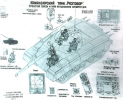


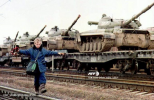
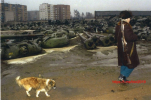
 (директор 115 БТРЗ, ЗИМ): Когда БТ технику ГСВГ начали гнать на Восток и Договор по обычным вооружениям в Европе, уже заработал, по нарядам ГБТУ МО СССР в 1990-1991 гг, все 432-е машины и значительная часть об. 434 были со 115 БТРЗ направлены на базы Атар (Казахстан) и Самарканд (Узбекистан). В количественном отношении их заменили "германские" 447. Насколько известно, последние 432-е в Украине порезали в 2007 г на базе Пирятин. Мы (Харьковский БТРЗ) пытались получить их, как компенсацию за хранение или за деньги. Не удалось. Металлоломщики оказались сильнее....
(директор 115 БТРЗ, ЗИМ): Когда БТ технику ГСВГ начали гнать на Восток и Договор по обычным вооружениям в Европе, уже заработал, по нарядам ГБТУ МО СССР в 1990-1991 гг, все 432-е машины и значительная часть об. 434 были со 115 БТРЗ направлены на базы Атар (Казахстан) и Самарканд (Узбекистан). В количественном отношении их заменили "германские" 447. Насколько известно, последние 432-е в Украине порезали в 2007 г на базе Пирятин. Мы (Харьковский БТРЗ) пытались получить их, как компенсацию за хранение или за деньги. Не удалось. Металлоломщики оказались сильнее....